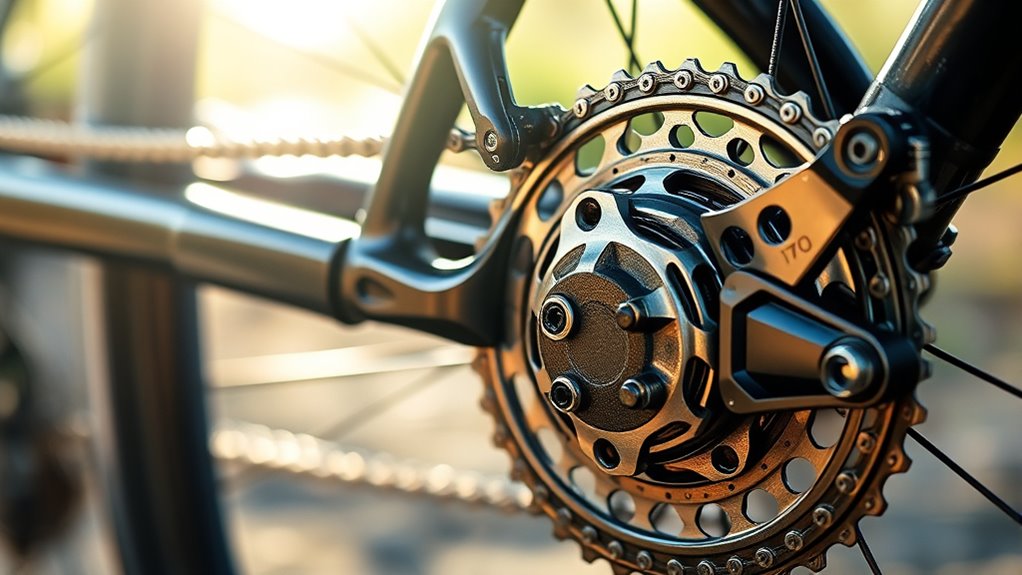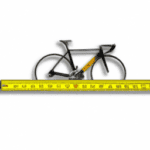To understand bike components and their functions, you should know how each part works together. The frame provides the structure, made from materials like steel, aluminum, or carbon fiber, affecting weight and durability. The steering system includes handlebars, stem, and headset for control. The drivetrain, with chain, gears, and crankset, transfers your pedaling power. Brakes, wheelsets, and specialized parts all contribute to how your bike performs. Exploring these details helps you optimize your ride and troubleshoot issues efficiently.
Key Takeaways
- Bike frames are made from various materials like steel, aluminum, carbon fiber, and titanium, each offering different durability, weight, and cost benefits.
- The drivetrain includes components such as chain, cassette, derailleurs, and crankset, which work together to convert pedaling into motion.
- Braking systems can be disc, rim, or V-brakes, each designed for different terrains and weather conditions, providing stopping power and control.
- Handlebars, stems, and headsets are key steering components that influence bike fit, handling, and maneuverability.
- Wheelset elements like hubs, rims, spokes, and rotors are essential for smooth rotation, strength, and effective braking performance.
Frame Structure and Materials
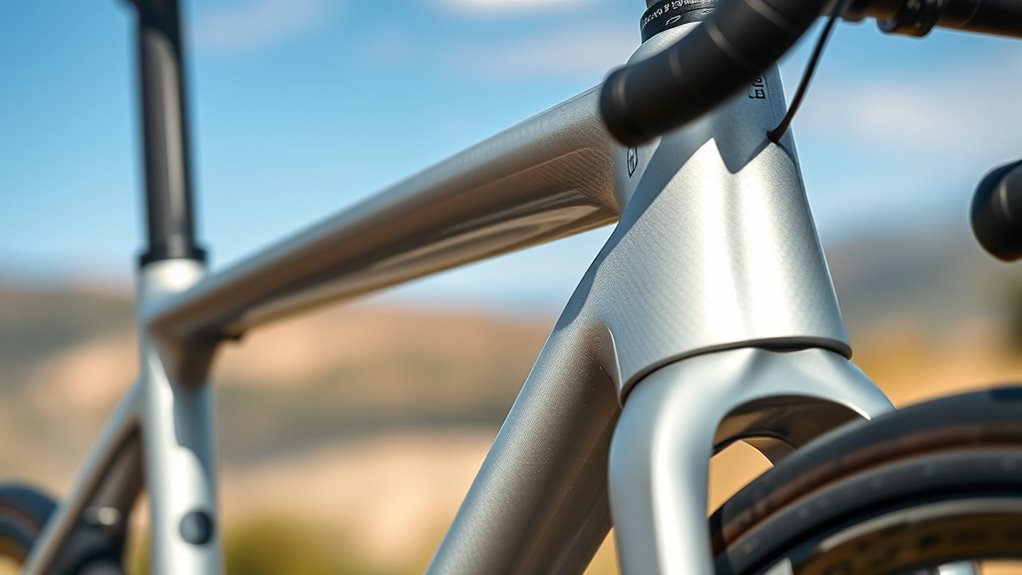
The frame structure and materials of a bicycle play a crucial role in determining its performance, durability, and weight. You’ll find steel, aluminum, carbon fiber, and titanium as primary options, each with unique benefits. Steel, especially chromoly steel, offers durability and smooth ride quality thanks to vibration damping, plus it’s affordable and easy to repair. Aluminum frames are lighter—about 30-40% less weight—and provide stiff power transfer, but they tend to have a shorter lifespan. Carbon fiber frames are the lightest, maximizing stiffness for racing, but come with a higher price tag. Titanium combines steel’s longevity with lightweight properties and corrosion resistance, though it’s costly. Less common materials like magnesium or hybrid frames also exist, often tailored for specific performance needs. Proper maintenance of bike components can significantly extend their lifespan and performance, especially considering the material properties that influence how a frame reacts to stress and environmental factors. Additionally, material fatigue can occur over time, affecting the integrity of the frame if not properly inspected and maintained. Understanding the stress distribution within different frame materials helps optimize design and durability.
Steering System Components
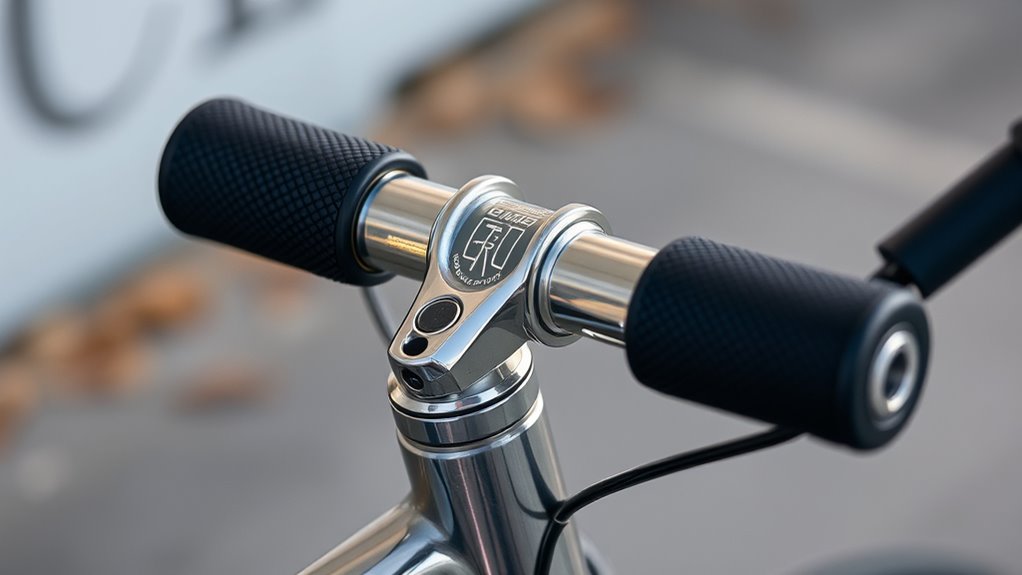
Understanding the components of a bicycle’s steering system helps you grasp how your bike responds to your movements. The handlebars are your primary control, supporting brake levers, gear shifters, and grips for comfort.
Knowing your bike’s steering parts helps you control and maintain it effectively.
The stem connects the handlebars to the frame, allowing adjustments for fit. The headset enables smooth rotation of the fork, which absorbs shocks and directs steering.
Spacers help customize handlebar height, while cables and housing control brakes and gears. Your grips provide control and comfort, influencing your handling.
Regular maintenance, like inspecting cables, adjusting the headset, and aligning the stem, keeps the system responsive.
Upgrades such as different handlebar styles, materials, or brake systems can enhance performance and comfort.
Understanding these parts helps you maintain and customize your bike for optimal control.
Drivetrain Mechanics and Parts
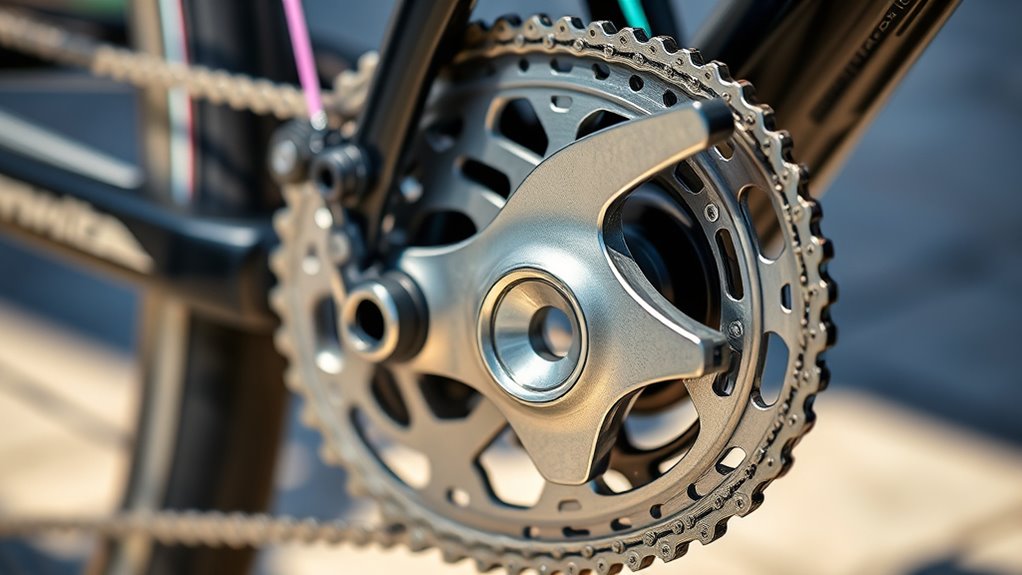
A bicycle’s drivetrain is the core mechanical system that transforms your pedaling effort into forward motion, allowing you to accelerate and maintain speed. It transfers force from your legs to the rear wheel through components like the chain, cassette, derailleurs, and crankset. The chain links these parts and needs lubrication for smooth operation. The cassette, a cluster of gears at the rear, determines gear ratios, while derailleurs move the chain between gears for shifting. The crankset, with chainrings and crank arms, converts your pedaling into torque. Adjusting gear ratios by pairing chainrings and cogs helps optimize speed and climbing efficiency. Regular maintenance, such as checking chain wear and derailleur alignment, keeps the drivetrain functioning smoothly and prolongs its lifespan. Modern bike drivetrains also incorporate efficient gear shifting technology to enhance performance and ease of use. Additionally, understanding the power transfer process is essential for optimizing riding efficiency and comfort. Proper alignment and tuning of components can significantly improve shifting accuracy, making rides more enjoyable and effective. For optimal performance, upgrading to high-quality components can also provide smoother operation and increased durability. Staying aware of component compatibility ensures that upgrades fit seamlessly and work correctly together.
Braking Systems and Their Operation

Braking systems are essential for controlling your bike’s speed and ensuring safety during rides. You’ll find three main types: disc brakes, rim brakes, and V-brakes.
Disc brakes, common on mountain and road bikes, offer strong stopping power and work well in various weather conditions. They can be hydraulic, which provides smooth operation, or mechanical, using cables. Additionally, disc brakes are often more durable and require less frequent adjustments, making them suitable for challenging terrains.
Rim brakes make contact with the wheel rim using brake pads. They are less powerful but lighter and simpler, often used on older or budget bikes. Proper maintenance, like cleaning and replacing pads, keeps these systems effective.
V-brakes, a form of rim brake, pull the pads against the rim via a cable. They are ideal for casual riding. A good understanding of braking system operation can help in selecting the right type for your riding style and terrain.
Your choice depends on riding conditions, terrain, and budget.
Additionally, the effectiveness of these braking systems can be enhanced by understanding the security features available for bicycles, such as lock mechanisms and alarm systems, which can prevent theft and increase overall safety.
Wheelset Elements and Functions
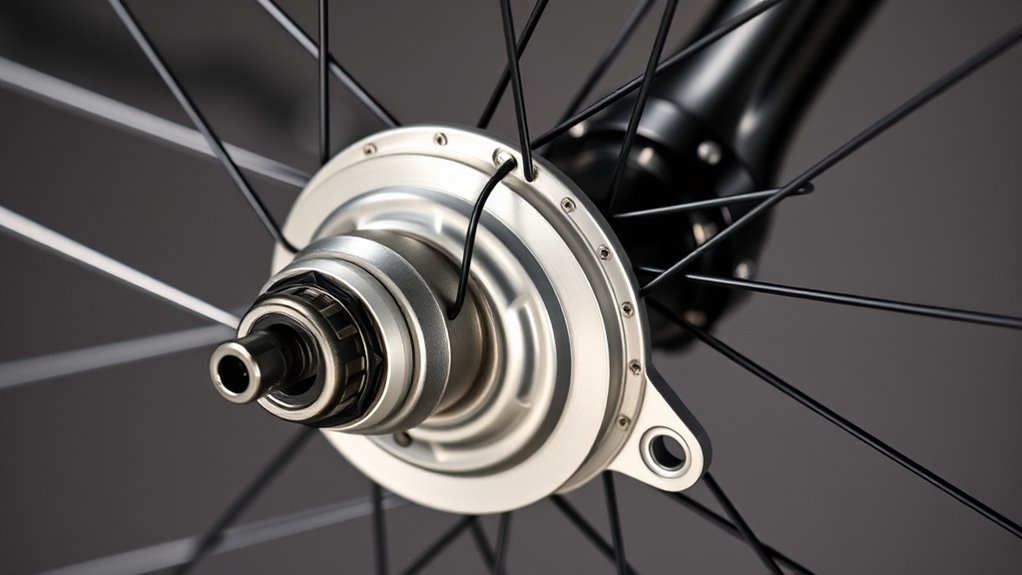
Focusing on the key elements that make up your bike’s wheelset reveals how each part contributes to performance and durability. The hub is central, housing bearings that guarantee smooth rotation and reduce friction. It also connects to the drive system through the driver body, which engages with the cassette or freewheel. The end caps secure internal parts and fit the bike’s dropouts, while rotor mounts attach disc brakes for stopping power. The rim forms the wheel’s outer structure, holding the tire and absorbing impacts. Rims can be aluminum or carbon fiber, with tubeless-ready designs for easy sealant application. Spokes connect the rim to the hub, with their tension influencing strength and stiffness. Proper tensioning and lacing patterns affect wheel integrity, ensuring a reliable, high-performing wheelset. Additionally, using high-quality wheelset components enhances overall durability and riding comfort. Understanding wheelset design and selecting appropriate parts can significantly improve your bike’s performance and longevity. Paying attention to tire compatibility and pressure can further optimize ride quality and efficiency.
Specialized Bicycle Components
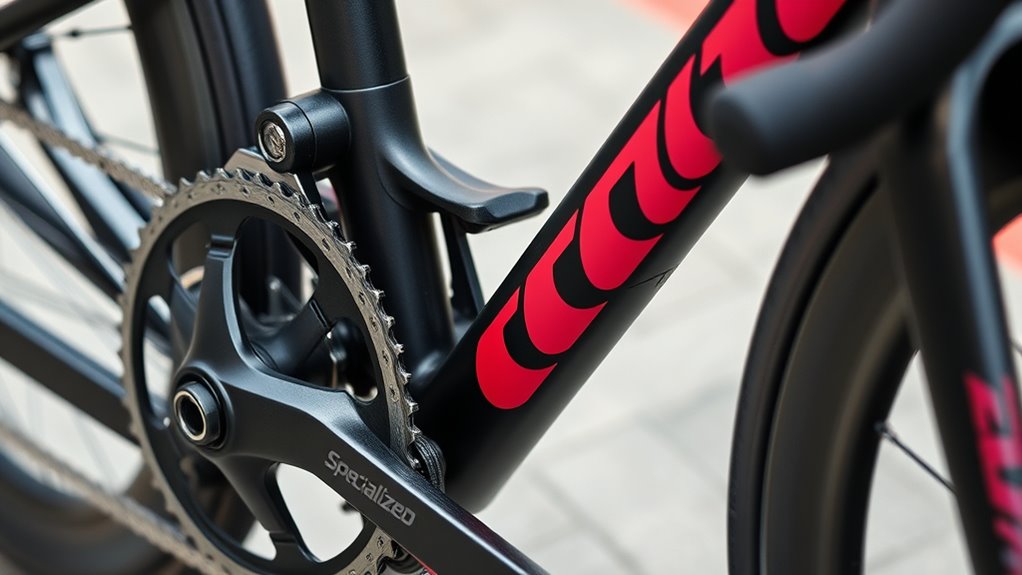
Your bike’s performance relies heavily on specialized components that optimize comfort, durability, and functionality across various riding conditions. Tires like the Mondo Folding Endurance and Pathfinder TLR offer low rolling resistance and puncture protection, perfect for endurance or gravel riding. The Sawtooth 2Bliss Ready provides tubeless compatibility for mixed terrain, while lightweight Cotton tires excel in racing. Service components like the Downtube Protector shield your frame from debris, and the SWAT Door offers integrated storage for tools and nutrition. These features contribute to a safe riding environment, ensuring rider confidence in diverse conditions. Incorporating industry transformations such as AI automation and innovative logistics solutions can further enhance your bike maintenance and accessories management. Utilizing innovative material technologies in components can also improve durability and performance over time. Pedals such as Bennies and Boomslang feature durable materials and replaceable pins for grip. Gravel-specific parts, including tubeless-ready rims and multi-surface treads, enhance stability and traction. Custom features like Hydra2 hubs and rim designs improve power transfer and ride comfort, adapting your bike for ideal performance. Creating a comfortable and functional riding environment is also crucial for overall bike performance and rider enjoyment.
Differences Between Mountain and Road Bike Frames
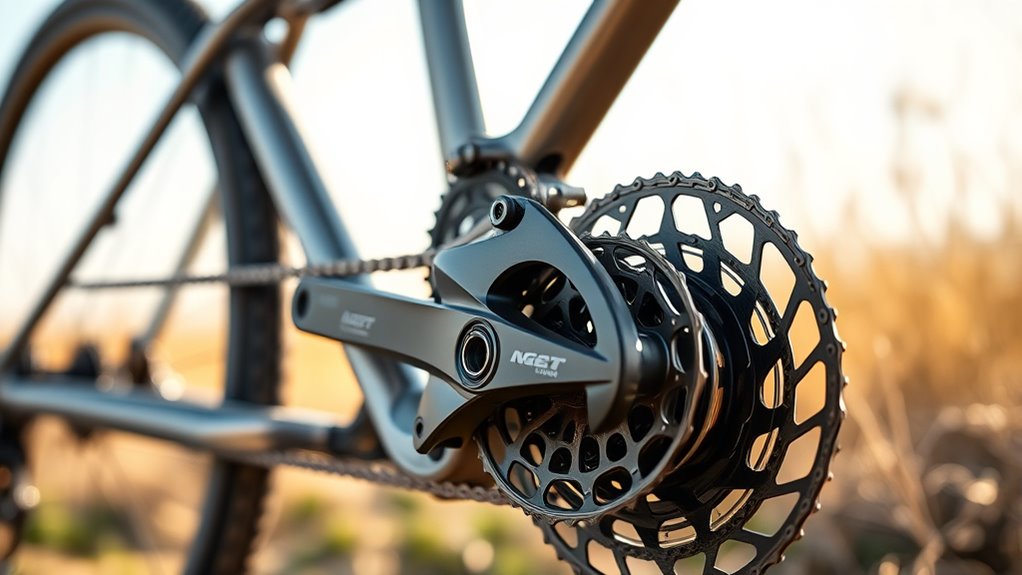
The design of mountain and road bike frames differs considerably to suit their specific riding environments.
Mountain bikes have shorter reach and top tubes, promoting an upright riding position that offers better control on rough trails. Their slacker head tube angles and larger fork rakes provide stability during steep descents, while increased trail measurement enhances off-road handling.
Conversely, road bike frames emphasize aerodynamics with steeper head tube angles and longer reach, enabling quicker steering and efficient riding on paved surfaces. Road bikes also feature thinner, smoother tires for reduced rolling resistance, while mountain bikes use wider, more aggressive tires for traction.
Frame materials vary to optimize each bike’s purpose, with mountain bikes prioritizing durability and control, and road bikes focusing on lightweight speed and efficiency.
How Bike Components Work Together

Bike components are designed to work together seamlessly to guarantee smooth power transfer and efficient shifting. Your chain connects to chainrings and cassettes, transmitting power from pedaling to the wheels. The rear derailleur shifts the chain across cassette sprockets via cables or electronic signals, changing gears smoothly. Proper chain tension and alignment are essential to reduce friction and wear. Expiration of vape juice can impact the performance of lubricants and other components, highlighting the importance of maintenance. Regular inspection of drivetrain components ensures all parts are functioning correctly and helps prevent costly repairs. Integrated drivetrains ensure all parts collaborate smoothly, providing reliable performance. This synergy lets you shift gears effortlessly, optimize power transfer, and maintain efficiency across different terrains. When components work well together, your ride feels responsive and effortless. Additionally, understanding Chevrolet Tuning techniques can help optimize vehicle performance, similar to fine-tuning bike components for peak efficiency.
Frequently Asked Questions
How Do I Choose the Right Bike Frame Material?
When choosing a bike frame material, consider your riding style, budget, and priorities.
If you want lightweight and high performance, go for carbon fiber or titanium.
For durability and affordability, steel or aluminum work well.
Think about maintenance and long-term use—steel and titanium last longer with less care, while aluminum and carbon are lighter but may need more attention.
Match the material to your riding goals for the best fit.
What Maintenance Does Each Component Require?
Maintenance might seem tedious, but it’s essential for your bike’s performance. You lubricate the chain and pivot points to prevent squeaks, replace brake pads when worn, and check tire pressure weekly for safety.
Cleaning your frame and drivetrain keeps grime at bay, while inspecting spokes and bearings ensures smooth rides. Regularly servicing these components keeps your bike reliable, safe, and ready whenever you are, transforming maintenance into a simple routine rather than a chore.
How Do I Upgrade My Bike’s Parts Effectively?
To upgrade your bike effectively, start by identifying which components need improvement based on your riding goals and budget.
Research compatible parts, focusing on mid-range options for a good balance of performance and cost.
Visit a professional bike shop for installation and advice.
After upgrading, get a proper bike fit, and test everything thoroughly to guarantee smooth operation and comfort.
Regular maintenance keeps your upgrades lasting longer.
What Are Common Signs of Component Wear or Failure?
Did you know that over 70% of bike accidents happen due to worn-out components? When checking for wear or failure, look for brake pads with worn indicators, tires with reduced tread or sidewall cracks, and chains that are stretched or rusty.
Keep an eye on wheel cracks, loose bearings, and worn gears. Regular inspections help you spot these signs early, ensuring your ride stays safe and smooth.
How Do Different Terrains Affect Component Performance?
Different terrains markedly impact your bike’s components. Mud and sand cause faster wear on chains and cassettes. Wet conditions require special lubricants to prevent rust.
Hills put extra stress on your drivetrain, and gravel vibrations can misalign derailleurs.
Steep descents wear brake pads quickly, and muddy surfaces reduce braking efficiency.
To keep your bike performing well, clean components often, use appropriate lubricants, and choose parts suited for specific terrains.
Conclusion
Now that you’ve explored bike components and their functions, you’re equipped to understand how each part works together like a well-oiled machine—no need for a knight’s armor here. Remember, just as a ship’s helmsman relies on the wheel, you depend on your bike’s components to keep you rolling smoothly. Whether you’re riding through the city or conquering trails, knowing your bike is your trusty steed will always steer you right.
